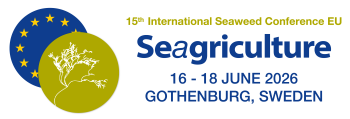Interview with Pi Nyvall Collén, Seagriculture advisory committee member
Interview with Pi Nyvall CollénFor today’s interview, I spoke with Seagriculture Advisory Committee member Pi Nyvall Collen. Pi currently works as an R&D manager with the Olmix Group, based in Bréhan, France. She holds an MSc in Biology, a PhD in Plant Physiology (on the starch metabolism in red algae), after which she worked as a post-doc on constructing a cDNA library from red alga Gracilaria with the University of São Paulo. And, not unimportant to add, she speaks at this year’s edition of Seagriculture! |  |
To begin with the basics: let’s discuss roots! Why are you in algae research, and how did you get here?
I always knew that I wanted to work with plants, but I never aimed for a PhD or working in algae in general. That all changed when I met the dynamic teacher Marianne Pedersen at my university – she was working with seaweed at the time, and she inspired me to get into algae as well.
Now, I’ve seen your resume, and the word ‘algae’ already makes an appearance in 1993, after which the whole document breathes algae so to speak. So, asking you as an expert with a long track record in algae research, what would you like to see changed to further the development of the algae industry?
I find that sometimes legislation is too static: sometimes, a date for a certain change in legislation is announced, but when the day comes, nothing happens. I think sometimes it’s better to adopt a maybe less perfect piece of legislation instead of letting the status quo continue.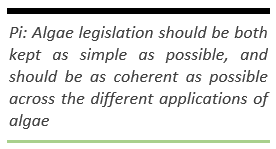
Also, I would encourage legislators to be better on two points: 1. to bring regulations back to a minimum and 2. to aim for coherence when creating legislation. I now find that legislation is sometimes incoherent across the differently purposed algae products: algal arsenic concentrations, for instance, are determined differently for human- and animal products respectively. As for decomplicating legislation, I simply feel this would reduce costs and make everybody’s life easier. On a side note, I feel that algae is becoming more mainstream with nontraditional actors starting to take an interest.
Can you tell us something about your current work with Olmix?
My role with Olmix is to develop the strategy for extraction from algae, and to determine the purpose of the extracts to identify candidates for future products. This fits in the Olmix-philosophy as a whole. The company’s divisions, Plant Care, Animal Care and Human Care, innovate in pursuing the same objective: producing more with less, while improving food safety and respecting animals, people and the environment. We find our resources in algae, clays and trace elements.
Algae as a potential replacement for antibiotics in livestock farming is an increasingly hot topic. How do the products developed at Olmix fit in the antibiotics debate?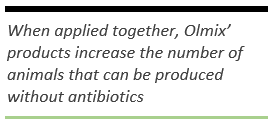
Olmix is working with three major French poultry operations, four medium-sized pig farms and a turkey integrator to develop its antibiotic free program thanks to algae. The strategy is the same for all species, a full audit of the farms then recommendations regarding the management, feed, vaccination and buildings and finally implementation of our range of solutions for environmental hygiene, mycotoxin risk, immunity and digestive efficacy and welfare. Basically, the Olmix products together increase the number of animals that can be produced without antibiotics.
I had a look at your Seagriculture presentation of a previous edition, in which you spoke about the research behind the Olmix product portfolio. One thing caught my eye: in your Searup trial, you observed a 41% less mortality in the treated group compared to control group. I would say that is an amazing result, is the product adopted by farmers accordingly? 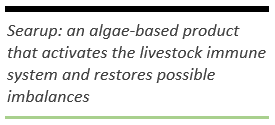
To be honest, I’m not really up to date on sales figures for Searup. But yes, results are good: we generally observe a decrease in mortality of between 20 and 40% after incorporating Searup in animal care programs.
But, it is still quite a new product, and I think we shouldn’t forget that livestock rearing is not an exact science where decisions are based on figures only: for the farmer, a change in habit or adopting a new product might seem a gamble.
A substantial part of your presentation of last year was reserved for the ULVANS project, with the objective of valorizing Brittany’s algal biomass. Can you elaborate on the timeline of the project, and give us an update on where you are now?
The Ulvans project ended 2015 and has allowed the proof of concept and development of harvesting and transformation tools. Currently, Olmix is working on a project called ‘Algolife’, which builds on the foundations layed down by the Ulvans project. Algolife aims to futher fine tune the extractions of active molecules from algae and to develop their application for both animal and human health and nutrition.
Now that the Ulvans project has just ended, I suppose the project’s milestones and setbacks are still freshly in your memory! Would you care sharing your thoughts?
Well, let me start by saying that the Ulvans project is what pulled me into Olmix. I liked the idea of working on repurposing something that is now considered a nuisance into something useful. Plus, I immediately liked the project’s bottom-up approach – that’s rare in algae research. Apart from the source material, which would of course be the algae found off the coast of Bretagne, the rest of the processes in the value chain were still open. In the end, the project really proved to be a success for all the partners involved.
Being really enthusiastic about the Ulvans project, I was amazed at the resistance we encountered. The project dealt with political pressure, and algal blooms are a sensitive topic among the Breton people. While we worked from the idea that somebody, if not us, should explore the benefits of algae as a resource to the fullest, politicians said that exploiting algae sends a signal to farmers that it is okay to pollute the waters further. I think that while the algae are there, we should benefit from them, and when they do dissappear, it is up to the industry to find or create alternative algae sources. At Olmix, for instance, we are looking into starting our own algae production.
So in general, the project was perceived really poorly. Didn’t that frustrate you, as you were basically recycling something considered useless into valuable products that would ultimately benefit a whole sector?
Yes, I found it hard to understand. When I explained to people one-on-one what the project entailed, everybody was real enthusiastic about the fact that we were adding value to a biomass regarded as waste, so to say. That the general perception was this negative, I didn’t expect.
I suppose that Olmix as a pioneer in exploiting Breton algae is sort of the ‘high tree catching the wind’ as we say in the Netherlands, or are there others involved in Breton algae exploitation?
There are quite a few actors using algae both for food products and for plant applications, mainly based on brown algal extracts, and a few actors also for animal applications. We see an increase in the number of actors at the moment, which we see as beneficial, as it allows to validate seaweed as an interesting ingredient.
I approached you for this mini-interview because of your role as a Seagriculture advisory committee member. Why did you become involved in the committee?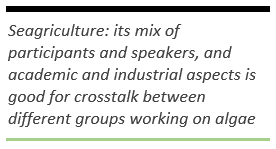
I decided to join the advisory committee because I found the mix of academic and industrial aspects represented in the Seagriculture programme interesting, and a good introduction.
I’ve seen your presentation from last year, but what we’re all really interested in is what you’ll be talking about this year! You are in session 6, high volume products, seaweed for feed and food. Can you give us a hint what you’ll be talking about?
That would spoil the surprise.
Okay then, we accept this touch of mystery. Let me ask you then what you thought of last’s year’s edition?
I found the mix of participants and speakers good for crosstalk between different groups working on algae. It would have been an excellent symposium for several of my collegues. For this edition, I hope that some of my collegues will be able to attend and profit from the presentations.
Visit the Olmix website for more information
